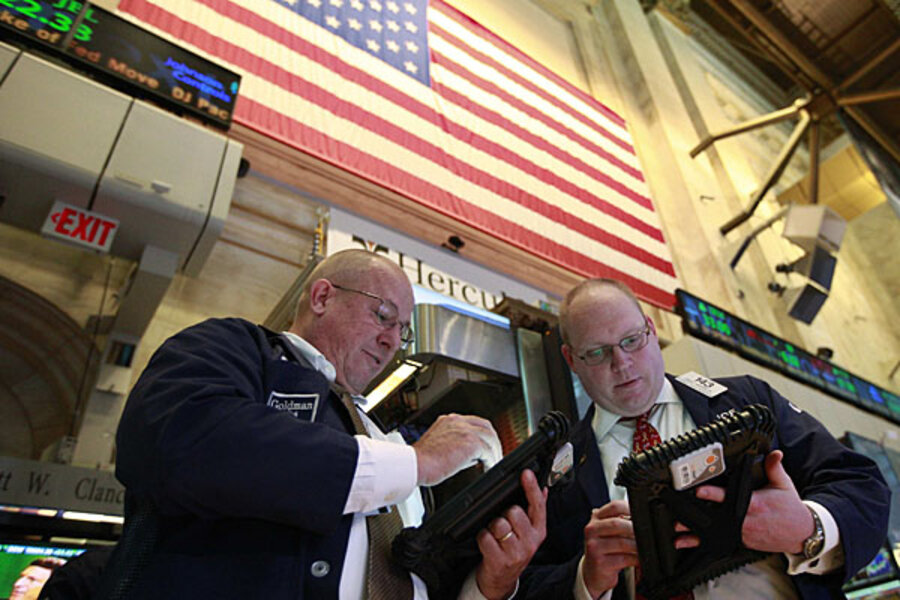Stocks continue surge after Fed bailout
Loading...
| New York
The stock market rose again Friday because of economic help from the Federal Reserve. But even some of the buyers weren't believers.
The Dow Jones industrial average hit its highest close since the pre-crisis days of November 2007. The Russell 2000 index of smaller companies briefly traded above its all-time closing high.
Markets rallied around the world in places where traders were getting their first chance to react to the Fed announcement: Stocks climbed more than 2 percent in India and France and almost 2 percent in Japan and Germany.
Apple, the most valuable company in American history, blew through its own all-time high and neared $700 per share as it started taking orders for the iPhone 5.
The gains came on top of a 206-point climb for the Dow on Thursday, when the Fed laid out additional plans to try to energize the economy, including buying $40 billion a month in mortgage bonds for as long as necessary.
But a day later, even with the market rising, plenty of investors were unconvinced. They bought stock, but they also worried that the Fed can't do much to fix the economy and predicted that the stock market gains would be short-lived.
Tyler Vernon, chief investment officer of Biltmore Capital in Princeton, N.J., wanted to capitalize on the market euphoria while he could. That the Fed is still taking such aggressive steps to boost the economy, four years after the financial crisis, doesn't give him much comfort.
The Fed, Vernon said, is "like the morphine being pumped into the patient. It keeps the patient walking and talking."
The Dow rose as much as 113 points Friday before pulling back. It ended up 53.51 points to 13,593.37. It is a 4 percent rally away from its all-time high of 14,164, reached Oct. 9, 2007.
The Standard & Poor's 500 rose 5.78 to 1,465.77, almost exactly 1,000 points below its all-time high. The Nasdaq composite index, which has been trading at the highest levels since 2000, climbed 28.12 to 3,183.95.
The Russell, which tracks 2,000 stocks with market values below $5 billion, closed at 854.70, a hair under its all-time high of 865.29 on April 29, 2011. Because the index contains small companies, it is seen as a gauge of investors' risk tolerance.
In the steps it laid out Thursday, the Fed extended its pledge of super-low short-term interest rates into 2015, from its previous target of 2014. Its plan to buy mortgage bonds is part of a strategy known as quantitative easing, designed to get people and businesses to borrow and spend, and to raise stock prices.
To be sure, investors can find other reasons to buy besides the Fed action. Corporate profits are high, and stocks are not expensive by historical standards when compared to earnings.
The psychological effect of the Fed's action is important for the economy as well: If the Fed weren't buttressing the stock market and the Dow were thousands of points lower, consumers would feel less wealthy and cut spending.
But that didn't have everyone convinced that the Fed's moves will make much difference in the end.
Jeff Sica, president and chief investment officer of SICA Wealth Management in Morristown, N.J., was underwhelmed by the Fed's commitment to keep interest rates low. Short-term interest rates have been near zero for years, he noted.
"How many times can you refinance your house?" Sica said.
Dwight Johnston, chief economist of the California and Nevada Credit Union Leagues, expected the stock market gains to be short-lived — just like they were after other central bank moves, he said.
"The definition of insanity is doing the same thing over and over again and expecting different results," Johnston said. "I think this may qualify."
Data out Friday also underscored the tenuous state of the economy. U.S. industrial production fell in August by the largest amount in more than three years, the Fed reported.
Also, high gas prices drove up consumer prices in August by the most in three years, the Labor Department said. The national average for a gallon of gas is around $3.87, a hardship for many families.
Among other stocks making notable moves:
— The Children's Place clothing store rose $1.85, or 3 percent, to $60.67 after a Citi analyst opened coverage of the company with a "buy" rating.
— The Cracker Barrel restaurant chain slipped $2.04, or 3 percent, to $64.13 after a KeyBanc analyst cut his rating to "hold" from "buy," citing high food costs.
— Staples was up 25 cents, or 2 percent, to $12.21 after Fortune magazine reported that private-equity firms are considering buying the office-supply company.







